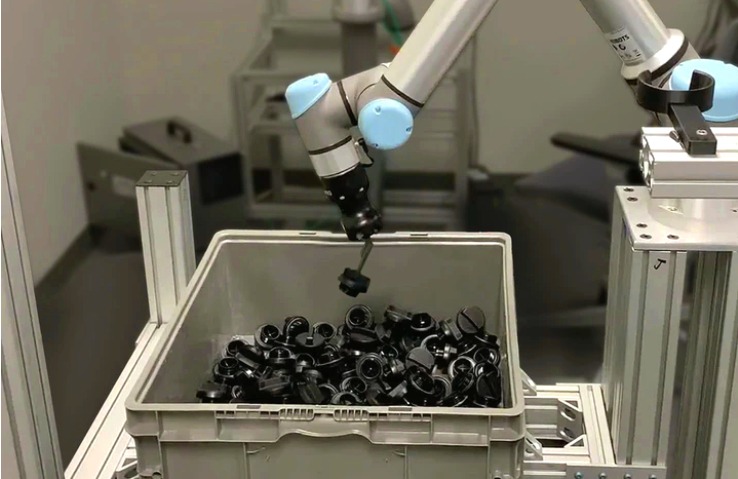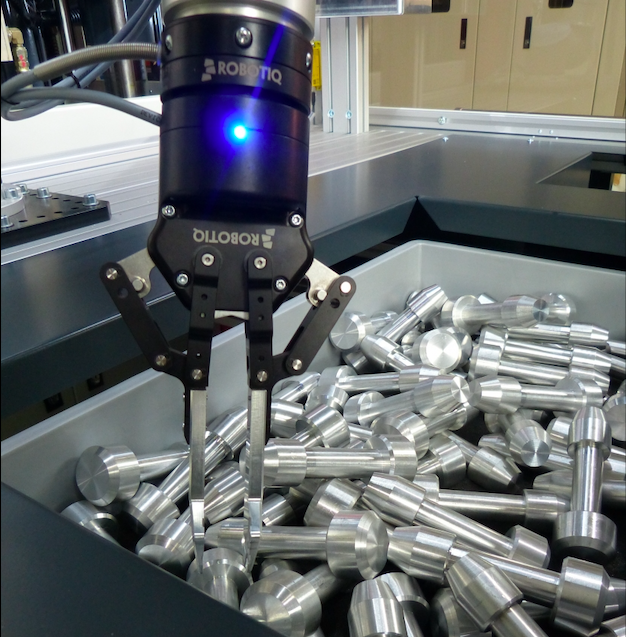Robotic Bin Picking: How to Mitigate the Business Risks

Posted on Oct 09, 2020 2:45 PM. 5 min read time
You might still have some reservations about bin picking, even if you're convinced of the benefits.
What will be the business effects of the robot?
Are there any risks to using bin picking?
How can you mitigate those risks?
You've probably done a lot of research into bin picking robots already. You've compared the different options on the market, identified which application would be best for you to deploy first, and jotted out a rough plan of how you will incorporate bin picking into your process.
You might even have gotten your stakeholders involved…
… but you haven't yet hit "Go" on your bin picking deployment project.
There are just a few nagging concerns that are holding you back.
As some people say: "Risk is not only inevitable; it’s consequential."
You don't want to be hit by the consequences of a bin picking risk that you could have avoided.
So what are the business risks of robotic bin picking?
What do most people say when you talk about robot risk?
Risk is a common topic in the world of robotics.
However, we are usually talking about the risk of physical harm caused by robots (or solved by it in some cases). The classic case with collaborative robots is that they are safe to operate around human workers, which can reduce the physical risk while increasing flexibility compared to industrial robots.
If you want to know more about the physical risks associated with robots,you can get started by checking out our Collaborative Robot Risk Assessment eBook and video series about risk assessment.
But, we're not talking about physical risk here.
We're talking about the potential negative impacts on your business of either employing a bin picking robot when it's unnecessary or failing to employ a bin picking robot when it really would be the best move.
This is a slightly trickier question to answer.
What are the potential business risks of robotic bin picking?
There are potential risks associated when you adopt any new technology. As tech security company QinetiQ explains "Organisations that adopt new technology […] risk wasting money on solutions that offer no benefit whilst exposing themselves to new and unforeseen threats."
You don't want to end up like the many companies that adopt new technology without first considering the effect that it will have on the people and processes within your business.
Unlike other robotic applications, bin picking is still a relatively new technology. Understandably, you might be more wary about it than other technology adoptions.
4 potential business risks of choosing bin picking
Here are some potential risks associated with robotic bin picking:
- Increased complexity — Almost all robotic technology will add some complexity to your processes. More complex systems tend to be riskier.
- Reduced agility (with some solutions) — Not all bin picking solutions are equal. Some of the more complex solutions will reduce the agility of your operation, making it harder to adapt to changes in your processes.
- Fear of automation from workers — A huge proportion of people are afraid of automation and its impact on their jobs. Adding any automation should be handled carefully or you may risk affecting morale.
- Loss of human cognitive abilities — Your bin picking task was probably previously carried out by a human. They were able to use their cognitive abilities to perform other tasks at the same time, like quality checking. Such tasks will need to be handled in another way or you risk reducing product quality.
4 potential business risks of NOT choosing bin picking
Our businesses are full of legacy systems. This is a common and highly understandable problem — we feel safe with our legacy systems. They are familiar so it feels like they carry no risk.
But, there are many risks to relying on legacy systems.
Here are some risks caused by not choosing bin picking:
- Left behind by the industry — When a new, easy to use technology comes out, companies are quick to jump on it. Your competitors will likely be using bin picking so you would be wise to keep up.
- Inefficiency in the operation — A bin picking robot can help to improve the efficiency of your process. If you don't solve this inefficiency, it will keep negatively affecting your production.
- Loss of workers with repetitive jobs — Bin picking tasks are dull and repetitive — that's why they are perfect for a robot. Such jobs are demotivating for employees and you may risk losing those people if you don't move them away from that task.
- Less capacity for innovation — When you give a task to a robot, you can usually move the person to a more value-added task. By keeping someone tied to a bin picking task, you're losing the opportunity that this person could help innovate the business.
How to implement a risk mitigation plan for bin picking
So, how do you avoid such business risks?
Just as you need to perform a risk analysis for the physical risks associated with robots, you should implement a "risk mitigation plan" to reduce the negative business effects of the robot.
A risk mitigation plan provides a structured process to identify the potential business risks before you deploy the bin picking robot. You can then prepare for those risks and plan ways to avoid them.
Risk mitigation planning basics
Risk mitigation planning is an iteractive process with various steps and methods. Here is the very basic overview from which you can start to further your research.
The four major stages of risk mitigation planning are:
- Risk identification — Outline the potential risks and any interactions between them.
- Risk impact assessment — Identify the probability of each business risk and the potential consequences of each.
- Risk prioritization analysis — Decide which of those risks are most critical for you to mitigate.
- Planning, implementation, and progress monitoring — Actively mitigate the most critical risks and track those that are less critical.
During this process, you will find that some of your concerns about bin picking are more relevant than others. These tasks will be specific for each business.
You will grade each business risk into 3 categories:
- High-criticality and medium-criticality — These risks should be avoided, controlled, or transferred to another part of the business that can assume them better.
- Low-criticality — These risks should be watched or assumed into the business.
Like any robot application, bin picking is a great solution if it solves a problem in your business.
Think that bin picking could be a good fit for you but you'd like to talk about it?
One of our integration coaches will be happy to help you work it out.
What could bin picking do for your business? Tell us in the comments below or join the discussion on LinkedIn, Twitter, Facebook, or the DoF professional robotics community.




Leave a comment